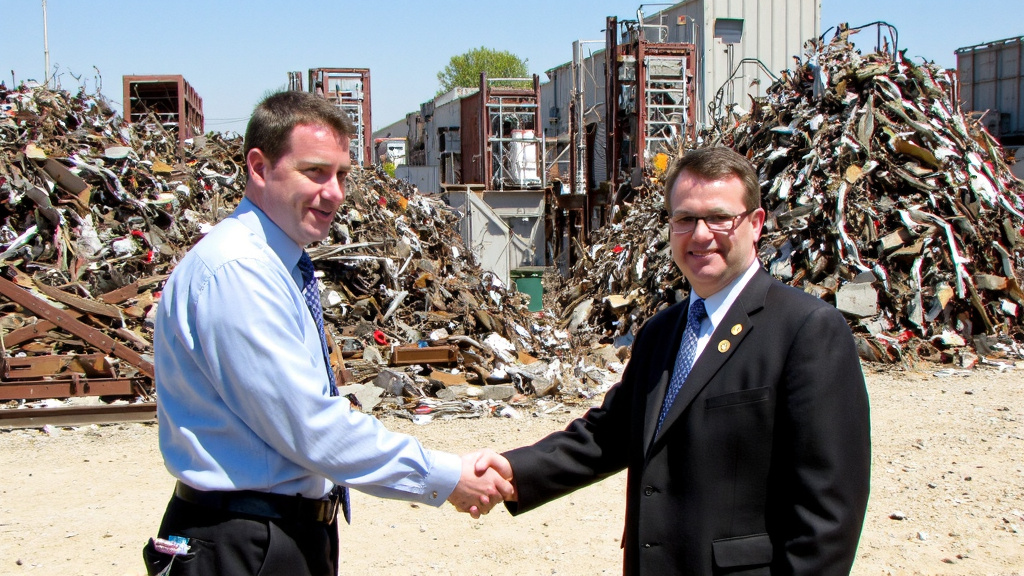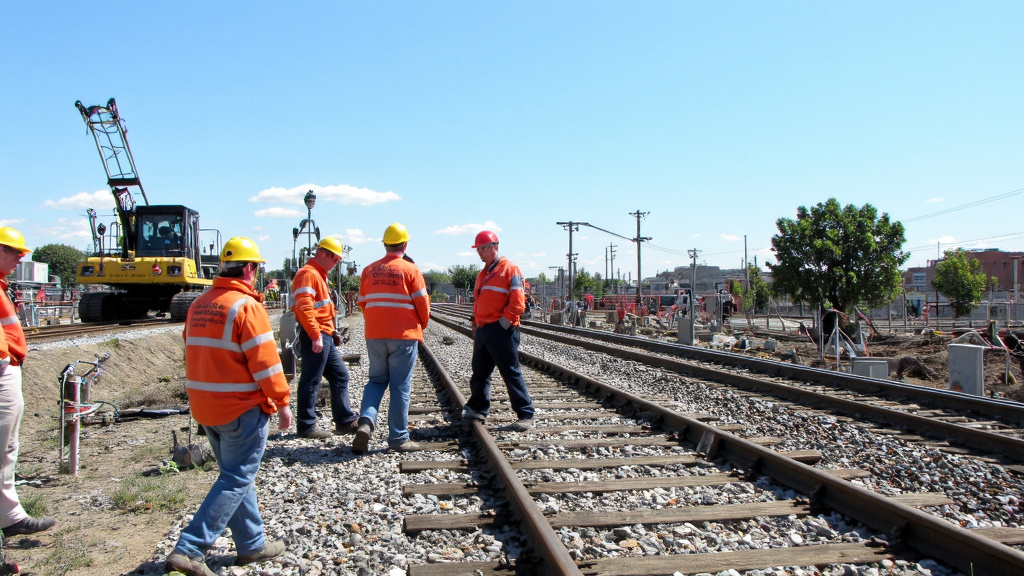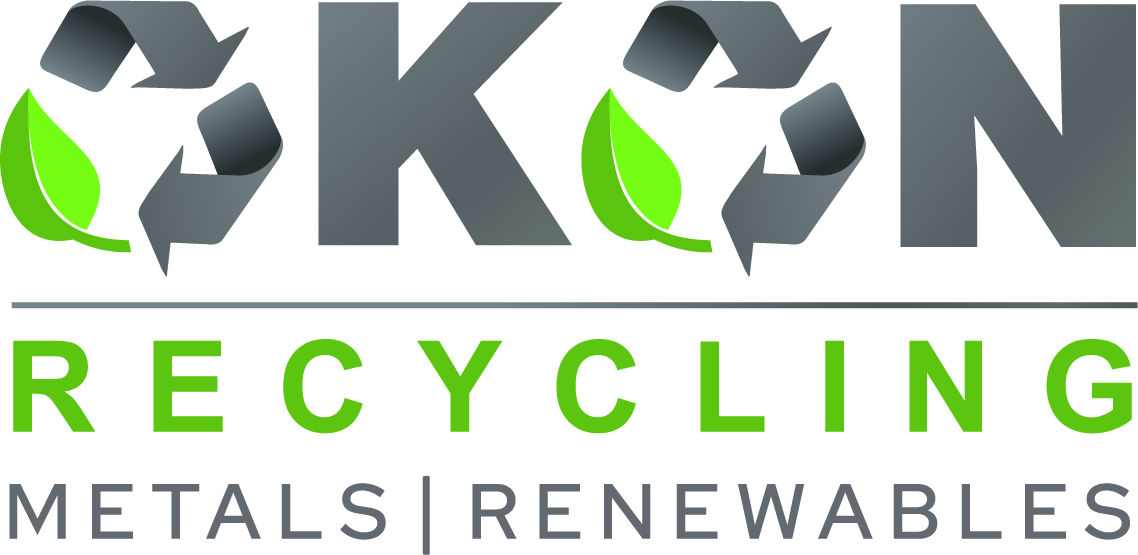5901 Botham Jean Blvd, Dallas, TX 75215
Learn About Government Incentives for Rail Recycling
April 16, 2025Government incentives for rail recycling are becoming more common as states and municipalities aim to divert materials from disposal and ease waste management burdens. These incentives, including tax credits, grants, and loans, support both existing and new recycling businesses in the rail sector.
With the Bipartisan Infrastructure Law and programs like the Consolidated Rail Infrastructure and Safety Improvements (CRISI), government entities are making significant investments in sustainable rail infrastructure. The focus on circular economy principles has made rail recycling essential for reducing waste and creating economic opportunities. Communities along rail corridors particularly benefit from these incentives, transforming what was once waste material into valuable resources.
The environmental benefits of rail recycling align with broader climate goals, which is why federal agencies like the EPA have developed specialized funding streams such as the Solid Waste Infrastructure for Recycling Grant Program.
What Types of Government Incentives Are Available for Rail Recycling?

Government incentives for rail recycling fall into three main categories: tax credits, grants, and loans. Each type offers distinct advantages to recycling companies looking to expand operations, invest in new equipment, or improve infrastructure. These incentives promote sustainability while supporting economic growth in the recycling sector.
Tax Credits and Deductions
Tax credits are a highly accessible form of government support for rail recycling operations. These incentives directly reduce a company’s tax liability, improving cash flow and encouraging investment in recycling infrastructure.
Investment tax credits are particularly valuable for recyclers purchasing new equipment. For example, several states offer credits ranging from 3-30% of equipment costs, with North Carolina providing deductions for both corporate income tax and franchise tax when businesses invest in recycling facilities or equipment. Delaware and Florida both offer recycling investment tax credits of $500 for each $100,000 invested, creating a direct financial benefit for expansion.
Property tax exemptions and deductions provide another significant financial advantage. Wisconsin offers recycling property tax exemptions specifically for machinery used exclusively in waste reduction or recycling processes. Similarly, North Carolina allows for real and personal property tax deductions for recycling plants and equipment, substantially reducing overhead costs.
Grants for Rail Recycling Projects
Government grants offer non-repayable funds that can significantly offset capital expenditures for rail recycling operations. Unlike tax incentives, grants provide upfront funding rather than after-the-fact tax relief.
Federal and state agencies distribute grants for various purposes, including equipment purchases, employee training, community education, and research and development. The Federal Railroad Administration, for example, offers significant funding through programs like the Consolidated Rail Infrastructure and Safety Improvements (CRISI) grants, which can support rail infrastructure improvements related to recycling operations.
Infrastructure development grants are particularly relevant for rail recyclers. These grants help companies install or improve access roads, storm sewers, water lines, and rail spurs. These improvements are critical for efficient recycling operations but often require substantial capital investment.
| Incentive Type | Description | Examples |
|---|---|---|
| Tax Credits | Reduces tax liability for recycling operations, improving cash flow. | North Carolina offers deductions for corporate income and franchise tax; Delaware and Florida offer $500 credits per $100,000 invested. |
| Grants | Non-repayable funds for capital expenditures like infrastructure improvements. | CRISI grants for rail infrastructure improvements. |
| Loans | Low or zero-interest loans for major projects with favorable terms. | Schnitzer Steel received a $750,000 state-supported loan. |
Low-Interest and Zero-Interest Loans
Government-supported loans provide financing opportunities with more favorable terms than traditional bank loans, enabling recycling companies to fund major projects with reduced financial burden.
Zero-interest loans eliminate the cost of borrowing entirely, while low-interest loans offer rates several points below prime commercial rates. Most of these loan programs provide extended repayment periods of 5-10 years, enhancing affordability and improving cash flow for borrowers.
For example, Schnitzer Steel Industries received a $750,000 state-supported loan to install an integrated shredding system, allowing them to expand their shredding capacity by 30% and create new jobs. New Jersey’s Department of Environmental Protection and Energy has provided similar loans to multiple recycling businesses, including a $100,000 five-year low-interest loan to Apache Auto Wreckers for a front-end loader purchase.
These loans often allow significant flexibility in how funds are used. While some states restrict usage to equipment purchases, others permit spending on buildings, land, and production and development costs. This flexibility enables recyclers to address their most pressing needs, whether that’s modernizing equipment or expanding facilities.
How Do Infrastructure Development Incentives Support Rail Recycling?

Infrastructure development incentives are crucial for supporting rail recycling operations through targeted funding that enhances operational capabilities and expands recycling capacity. These incentives often come as grants and loans to local governments for improvements that benefit recycling facilities, particularly those handling rail materials.
Access to well-maintained transportation networks is a significant support for rail recyclers. Grants for constructing or upgrading access roads facilitate efficient movement of equipment and materials to and from recycling sites. This improved accessibility reduces transportation costs and minimizes logistical challenges that could otherwise hinder recycling operations.
Rail spurs—dedicated short tracks connecting recycling facilities to main railway lines—are particularly valuable for the rail recycling sector. These connections allow recyclers to receive obsolete rail materials directly by train and ship processed recycled products efficiently to manufacturers. For facilities handling substantial volumes of heavy rail materials, these direct connections eliminate costly intermediary transportation and significantly increase operational efficiency.
Enterprise Zones and Industrial Development Regions
Infrastructure incentives are often concentrated within designated enterprise zones and industrial development regions, creating ideal conditions for rail recycling operations. These areas typically offer enhanced infrastructure support to attract and retain industrial businesses, including recyclers.
In enterprise zones, counties and municipalities may receive preferential funding to develop comprehensive infrastructure systems that support multiple recycling facilities simultaneously. This can include advanced stormwater management systems that help recycling operations meet environmental compliance requirements while managing runoff from material storage areas.
Water line extensions are another crucial infrastructure development. Recycling processes often require significant water resources for operations like cooling equipment or washing recovered materials. Infrastructure grants for water line installations ensure recyclers have reliable access to this essential resource, making previously undeveloped locations viable for recycling operations.
Direct Operational Benefits
Infrastructure incentives directly benefit a recycling company’s bottom line. Improved storm sewers and drainage systems allow facilities to operate effectively even during adverse weather, reducing downtime and maintaining consistent production schedules. This reliability is crucial in rail recycling, where operations often involve managing large quantities of materials in outdoor processing areas.
Electrical infrastructure improvements also support operational expansion. Enhanced electrical capacity allows recyclers to install power-intensive processing equipment like shredders, balers, and material separation systems. This capability enables facilities to process more complex rail components and recover a broader range of valuable materials from obsolete rail infrastructure.
The recycling industry depends on modern and efficient transportation infrastructure to move scrap to market, whether by truck, rail, ship, or barge. Infrastructure development incentives that address these fundamental needs create conditions where rail recycling operations can establish, expand, and adapt their facilities to meet evolving industry demands while maintaining economic viability.
What Are Real-World Examples of Rail Recycling Incentives in Action?

Government incentives for rail recycling have created tangible opportunities for companies across the United States. These financial support mechanisms have transformed business operations, increased processing capacities, and generated positive economic impacts within their communities. Let’s examine some notable success stories that demonstrate the real-world effectiveness of these programs.
Schnitzer Steel Industries’ Expansion Project
Schnitzer Steel Industries Inc. represents one of the most compelling examples of successful incentive utilization in the rail recycling sector. The company secured a substantial $750,000 state-supported loan specifically earmarked for technological advancement. This capital infusion enabled Schnitzer to install an integrated shredding system that significantly enhanced their operational capabilities.
The results of this investment proved remarkably effective. With the new system in place, Schnitzer experienced a 30% increase in processing capacity—a dramatic improvement that allowed them to handle substantially more rail material while improving efficiency. Beyond the immediate operational benefits, this expansion generated additional employment opportunities, creating new jobs in an industry that contributes to environmental sustainability.
Schnitzer’s facility transformation included extensive infrastructure modifications, with the installation of specialized conveyor systems and processing equipment designed specifically for handling rail materials. The waterfront location of some of their facilities provides strategic advantages for material transportation, further maximizing the efficiency gains from the government-backed investment.
New Jersey’s Multi-Firm Support Initiative
New Jersey has emerged as a notable hub for recycling incentive programs, with multiple scrap firms benefiting from state-sponsored financial support. The state’s approach has been particularly effective in distributing resources across various companies rather than concentrating on a single large operation, creating a more diverse and resilient recycling ecosystem.
Several New Jersey-based scrap firms have received loans ranging from $100,000 to $200,000 through these programs. While individually smaller than Schnitzer’s funding, these targeted investments have enabled critical equipment purchases and facility improvements that might otherwise have remained financially out of reach for smaller market participants.
These modernization efforts have allowed New Jersey recyclers to enhance their metal processing capabilities while simultaneously improving environmental compliance measures. The distributed nature of this support has strengthened the overall rail recycling infrastructure across the state, creating a network of more capable processors rather than relying on a single dominant facility.
Common among both Schnitzer Steel and the New Jersey examples is the focus on technology advancement and capacity enhancement rather than simple operational subsidies. This approach ensures that government funds create lasting improvements to recycling infrastructure rather than temporarily supporting business operations, establishing a more sustainable model for public-private partnerships in the recycling sector.
Conclusion: Leveraging Government Incentives for Rail Recycling Success
Government incentives for rail recycling offer valuable opportunities for businesses aiming to expand operations, enhance infrastructure, and strengthen their competitive position. From tax credits and exemptions to grants, loans, and infrastructure development support, these financial tools can significantly reduce costs and boost profitability. Although the paperwork requirements and concerns about government involvement may initially seem daunting, the long-term benefits—including improved operational efficiency, expanded capacity, and increased market competitiveness—make exploring these options worthwhile for forward-thinking recycling companies.
By strategically incorporating government incentives into business planning, rail recycling operations can improve their bottom line and contribute to broader waste management and sustainability goals. The recycling industry plays a crucial role in resource conservation and environmental protection, and available incentives acknowledge this important function.
Don’t let valuable opportunities for growth and advancement pass you by—contact Okon Recycling at 214-717-4083 to learn more about leveraging government incentives to strengthen your rail recycling operations.
